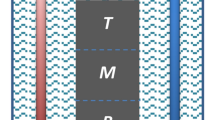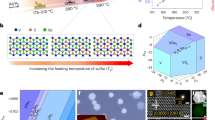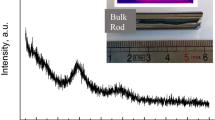Abstract
In situ tailoring of two-dimensional materials’ phases under external stimulus facilitates the manipulation of their properties for electronic, quantum and energy applications. However, current methods are mainly limited to the transitions among phases with unchanged chemical stoichiometry. Here we propose on-device phase engineering that allows us to realize various lattice phases with distinct chemical stoichiometries. Using palladium and selenide as a model system, we show that a PdSe2 channel with prepatterned Pd electrodes can be transformed into Pd17Se15 and Pd4Se by thermally tailoring the chemical composition ratio of the channel. Different phase configurations can be obtained by precisely controlling the thickness and spacing of the electrodes. The device can be thus engineered to implement versatile functions in situ, such as exhibiting superconducting behaviour and achieving ultralow-contact resistance, as well as customizing the synthesis of electrocatalysts. The proposed on-device phase engineering approach exhibits a universal mechanism and can be expanded to 29 element combinations between a metal and chalcogen. Our work highlights on-device phase engineering as a promising research approach through which to exploit fundamental properties as well as their applications.
This is a preview of subscription content, access via your institution
Access options
Access Nature and 54 other Nature Portfolio journals
Get Nature+, our best-value online-access subscription
$29.99 / 30 days
cancel any time
Subscribe to this journal
Receive 12 print issues and online access
$259.00 per year
only $21.58 per issue
Buy this article
- Purchase on Springer Link
- Instant access to full article PDF
Prices may be subject to local taxes which are calculated during checkout




Similar content being viewed by others
Data availability
The main data supporting the findings of this study are available within the paper and its Supplementary Information. Additional data are available from the corresponding authors upon reasonable request. Source data are provided with this paper.
References
Pelton, A. D. in Phase Transformations in Materials (ed. Kostorz, G.) 1–80 (Wiley Online Library, 2001).
Chen, Y. et al. Phase engineering of nanomaterials. Nat. Rev. Chem. 4, 243–256 (2020).
Sondhi, S. L., Girvin, S. M., Carini, J. P. & Shahar, D. Continuous quantum phase transitions. Rev. Mod. Phys. 69, 315–333 (1997).
Li, W., Qian, X. & Li, J. Phase transitions in 2D materials. Nat. Rev. Mater. 6, 829–846 (2021).
Yang, H., Kim, S. W., Chhowalla, M. & Lee, Y. H. Structural and quantum-state phase transitions in van der Waals layered materials. Nat. Phys. 13, 931–937 (2017).
Voiry, D., Mohite, A. & Chhowalla, M. Phase engineering of transition metal dichalcogenides. Chem. Soc. Rev. 44, 2702–2712 (2015).
Wang, Y. et al. Structural phase transition in monolayer MoTe2 driven by electrostatic doping. Nature 550, 487–491 (2017).
Cho, S. et al. Phase patterning for ohmic homojunction contact in MoTe2. Science 349, 625–628 (2015).
Wu, M. & Li, J. Sliding ferroelectricity in 2D van der Waals materials: related physics and future opportunities. Proc. Natl Acad. Sci. USA 118, e2115703118 (2021).
Ghiotto, A. et al. Quantum criticality in twisted transition metal dichalcogenides. Nature 597, 345–349 (2021).
Zhang, Q. et al. Simultaneous synthesis and integration of two-dimensional electronic compositions. Nat. Electron. 2, 164–170 (2019).
Oyedele, A. D. et al. Defect-mediated phase transformation in anisotropic two-dimensional PdSe2 crystals for seamless electrical contacts. J. Am. Chem. Soc. 141, 8928–8936 (2019).
Kappera, R. et al. Phase-engineered low-resistance contacts for ultrathin MoS2 transistors. Nat. Mater. 13, 1128–1134 (2014).
Zhang, F. et al. Electric-field induced structural transition in vertical MoTe2- and Mo1–xWxTe2-based resistive memories. Nat. Mater. 18, 55–61 (2019).
Sie, E. J. et al. An ultrafast symmetry switch in a Weyl semimetal. Nature 565, 61–66 (2019).
Yasuda, K., Wang, X., Watanabe, K., Taniguchi, T. & Jarillo-Herrero, P. Stacking-engineered ferroelectricity in bilayer boron nitride. Science 372, 1458–1462 (2021).
Wang, R. et al. Strategies on phase control in transition metal dichalcogenides. Adv. Funct. Mater. 28, 1802473 (2018).
Yu, Y. et al. High-temperature superconductivity in monolayer Bi2Sr2CaCu2O8+δ. Nature 575, 156–163 (2019).
Hu, Y. et al. Extendable piezo/ferroelectricity in nonstoichiometric 2D transition metal dichalcogenides. Nat. Commun. 14, 8470 (2023).
Ye, L. et al. Massive Dirac fermions in a ferromagnetic kagome metal. Nature 555, 638–642 (2018).
Liu, E. et al. Giant anomalous Hall effect in a ferromagnetic kagome-lattice semimetal. Nat. Phys. 14, 1125–1131 (2018).
Seo, J. et al. Nearly room temperature ferromagnetism in a magnetic metal-rich van der Waals metal. Sci. Adv. 6, eaay8912 (2020).
Hu, C. et al. Realization of an intrinsic ferromagnetic topological state in MnBi8Te13. Sci. Adv. 6, eaba4275 (2020).
Frey, N. C. et al. High-throughput search for magnetic and topological order in transition metal oxides. Sci. Adv. 6, eabd1076 (2020).
Wang, Y. et al. P-type electrical contacts for 2D transition-metal dichalcogenides. Nature 610, 61–66 (2022).
Oberoi, A. et al. Toward high-performance p-type two-dimensional field effect transistors: contact engineering, scaling, and doping. ACS Nano 17, 19709–19723 (2023).
Deng, D. et al. Catalysis with two-dimensional materials and their heterostructures. Nat. Nanotechnol. 11, 218–230 (2016).
Chia, X. & Pumera, M. Characteristics and performance of two-dimensional materials for electrocatalysis. Nat. Catal. 1, 909–921 (2018).
Zhao, X. et al. Engineering covalently bonded 2D layered materials by self-intercalation. Nature 581, 171–177 (2020).
Liu, X. C. et al. Spontaneous self-intercalation of copper atoms into transition metal dichalcogenides. Sci. Adv. 6, eaay4092 (2020).
Yu, Y. et al. Gate-tunable phase transitions in thin flakes of 1T-TaS2. Nat. Nanotechnol. 10, 270–276 (2015).
Lu, N. et al. Electric-field control of tri-state phase transformation with a selective dual-ion switch. Nature 546, 124–128 (2017).
Morosan, E. et al. Superconductivity in CuxTiSe2. Nat. Phys. 2, 544–550 (2006).
Kanetani, K. et al. Ca intercalated bilayer graphene as a thinnest limit of superconducting C6Ca. Proc. Natl Acad. Sci. USA 109, 19610–19613 (2012).
Chow, W. L. et al. High mobility 2D palladium diselenide field-effect transistors with tunable ambipolar characteristics. Adv. Mater. 29, 1602969 (2017).
Liu, X. et al. Temperature-sensitive spatial distribution of defects in PdSe2 flakes. Phys. Rev. Mater. 5, L041001 (2021).
Zhou, J. et al. A library of atomically thin metal chalcogenides. Nature 556, 355–359 (2018).
Lai, Z. et al. Metastable 1T′-phase group VIB transition metal dichalcogenide crystals. Nat. Mater. 20, 1113–1120 (2021).
Han, G. H., Duong, D. L., Keum, D. H., Yun, S. J. & Lee, Y. H. Van der Waals metallic transition metal dichalcogenides. Chem. Rev. 118, 6297–6336 (2018).
Zhao, B. et al. 2D metallic transition-metal dichalcogenides: structures, synthesis, properties, and applications. Adv. Funct. Mater. 31, 2105132 (2021).
Liu, L. et al. Phase-selective synthesis of 1T′ MoS2 monolayers and heterophase bilayers. Nat. Mater. 17, 1108–1114 (2018).
Liu, Y. et al. Promises and prospects of two-dimensional transistors. Nature 591, 43–53 (2021).
Shen, P. C. et al. Ultralow contact resistance between semimetal and monolayer semiconductors. Nature 593, 211–217 (2021).
Wang, Y. et al. Van der Waals contacts between three-dimensional metals and two-dimensional semiconductors. Nature 568, 70–74 (2019).
He, Y. et al. Amorphizing noble metal chalcogenide catalysts at the single-layer limit towards hydrogen production. Nat. Catal. 5, 212–221 (2022).
He, Y. et al. Engineering grain boundaries at the 2D limit for the hydrogen evolution reaction. Nat. Commun. 11, 57 (2020).
Voiry, D. et al. The role of electronic oupling between substrate and 2D MoS2 nanosheets in electrocatalytic production of hydrogen. Nat. Mater. 15, 1003–1009 (2016).
Yu, Y. et al. High phase-purity 1T′-MoS2- and 1T′-MoSe2-layered crystals. Nat. Chem. 10, 638–643 (2018).
Sun, Y. et al. Plasma-induced large-area N,Pt-doping and phase engineering of MoS2 nanosheets for alkaline hydrogen evolution. Energy Environ. Sci. 15, 1201–1210 (2022).
Yang, X. et al. Nitrogen-plasma treated hafnium oxyhydroxide as an efficient acid-stable electrocatalyst for hydrogen evolution and oxidation reactions. Nat. Commun. 10, 1543 (2019).
Zhu, J. et al. Boundary activated hydrogen evolution reaction on monolayer MoS2. Nat. Commun. 10, 1348 (2019).
Acknowledgements
This work was supported in part by the National Key R&D Program of China under grants 2023YFF1203600 (S.-J.L.) and 2022YFA1402500 (J.S.); the National Natural Science Foundation of China (62122036 (S.-J.L.), 62034004 (F.M.), 61921005 (F.M.), 62204112 (J.S.), 12074176 (B.C.), 12104206 (L.Z.) and 11974156 (J.L.)); the Strategic Priority Research Program of the Chinese Academy of Sciences (XDB44000000 (F.M.)); the Leading-edge Technology Program of Jiangsu Natural Science Foundation (BK20232004 (F.M.)); the Natural Science Foundation of Jiangsu Province (BK20220774 (J.S.)); the Guangdong Innovative and Entrepreneurial Research Team Program (2019ZT08C044 (J.L.)); the Shenzhen Science and Technology Program (20200925161102001 (J.L.) and 20210609103649046 (J.L.)); the Science, Technology and Innovation Commission of Shenzhen Municipality (ZDSYS20190902092905285 (J.L.)); and the Quantum Science Strategic Special Project from the Quantum Science Center of the Guangdong-Hong Kong-Macao Greater Bay Area (GDZX2301006 (J.L.)). STEM characterization was performed at the Pico Center from SUSTech Core Research Facilities, which receives support from the Presidential Fund and Development and Reform Commission of Shenzhen Municipality. F.M. and S.-J.L. acknowledge support from the AIQ Foundation and the e-Science Center of the Collaborative Innovation Center of Advanced Microstructures. We also acknowledge the microfabrication center of the National Laboratory of Solid State Microstructures (NLSSM) for their technical support.
Author information
Authors and Affiliations
Contributions
S.-J.L. and F.M. conceived the idea. S.-J.L. and F.M. supervised the whole project. X. Liu, J.S. and T.C. fabricated devices and performed electrical and Raman measurements. L.Z., G.W., Q.Y. and J.L. performed the electron microscopy experiments and data analysis. J.M. and X. Luo carried out the DFT calculations and data analysis. J.S., Z.S., M.M. and Y.H. carried out the measurements of electrocatalytic performance. J.S. and Z.L. carried out the measurements of contact resistance. X. Liu, S.Y. and L.W. grew the materials. J.S., Y.D., J.X., F.C., B.W., C.P. and B.C. assisted in device processing and characterization. Z.W. assisted in the Raman characterization. X. Liu, J.S., S.-J.L. and F.M. wrote the manuscript with input from all authors.
Corresponding authors
Ethics declarations
Competing interests
The authors declare no competing interests.
Peer review
Peer review information
Nature Materials thanks Won Yoo, Damien Voiry and the other, anonymous, reviewer(s) for their contribution to the peer review of this work.
Additional information
Publisher’s note Springer Nature remains neutral with regard to jurisdictional claims in published maps and institutional affiliations.
Supplementary information
Supplementary Information
Supplementary Figs. 1–22.
Source data
Source Data Fig. 1
Statistical source data.
Source Data Fig. 2
Statistical source data.
Source Data Fig. 3
Statistical source data.
Source Data Fig. 4
Statistical source data.
Rights and permissions
Springer Nature or its licensor (e.g. a society or other partner) holds exclusive rights to this article under a publishing agreement with the author(s) or other rightsholder(s); author self-archiving of the accepted manuscript version of this article is solely governed by the terms of such publishing agreement and applicable law.
About this article
Cite this article
Liu, X., Shan, J., Cao, T. et al. On-device phase engineering. Nat. Mater. (2024). https://doi.org/10.1038/s41563-024-01888-y
Received:
Accepted:
Published:
DOI: https://doi.org/10.1038/s41563-024-01888-y



